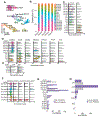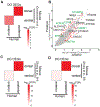Resolving cellular and molecular diversity along the hippocampal anterior-to-posterior axis in humans
- PMID: 34051145
- PMCID: PMC8273123
- DOI: 10.1016/j.neuron.2021.05.003
Resolving cellular and molecular diversity along the hippocampal anterior-to-posterior axis in humans
Abstract
The hippocampus supports many facets of cognition, including learning, memory, and emotional processing. Anatomically, the hippocampus runs along a longitudinal axis, posterior to anterior in primates. The structure, function, and connectivity of the hippocampus vary along this axis. In human hippocampus, longitudinal functional heterogeneity remains an active area of investigation, and structural heterogeneity has not been described. To understand the cellular and molecular diversity along the hippocampal long axis in human brain and define molecular signatures corresponding to functional domains, we performed single-nuclei RNA sequencing on surgically resected human anterior and posterior hippocampus from epilepsy patients, identifying differentially expressed genes at cellular resolution. We further identify axis- and cell-type-specific gene expression signatures that differentially intersect with human genetic signals, identifying cell-type-specific genes in the posterior hippocampus for cognitive function and the anterior hippocampus for mood and affect. These data are accessible as a public resource through an interactive website.
Keywords: hippocampus, single-cell genomics, cognition, memory, neurogenomics.
Copyright © 2021 Elsevier Inc. All rights reserved.
Conflict of interest statement
Declaration of interests The authors declare no competing interests.
Figures






References
-
- Bertelsen EN, Larsen JT, Petersen L, Christensen J, and Dalsgaard S (2016). Childhood Epilepsy, Febrile Seizures, and Subsequent Risk of ADHD. Pediatrics 138. - PubMed
-
- Bipolar D, Schizophrenia Working Group of the Psychiatric Genomics Consortium. Electronic address, d.r.v.e., Bipolar, D., and Schizophrenia Working Group of the Psychiatric Genomics, C. (2018).
Publication types
MeSH terms
Grants and funding
LinkOut - more resources
Full Text Sources
Other Literature Sources
Molecular Biology Databases

